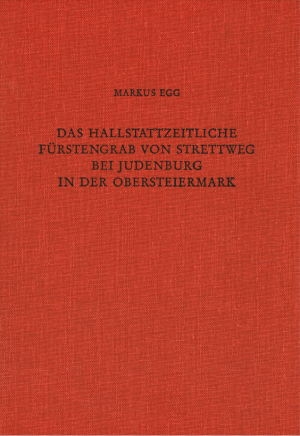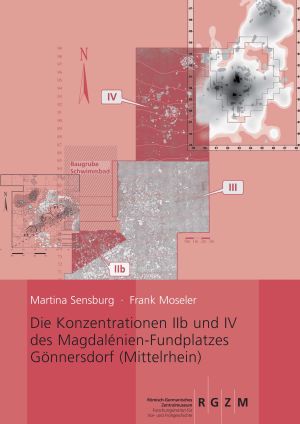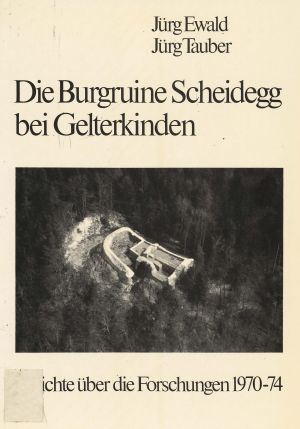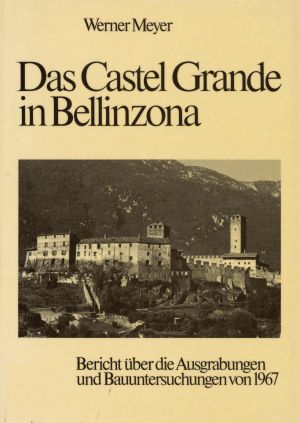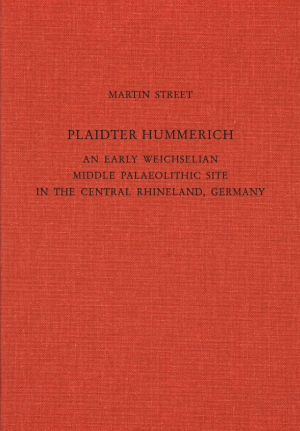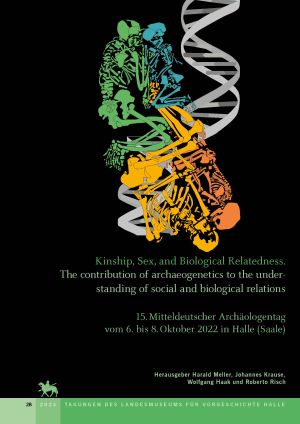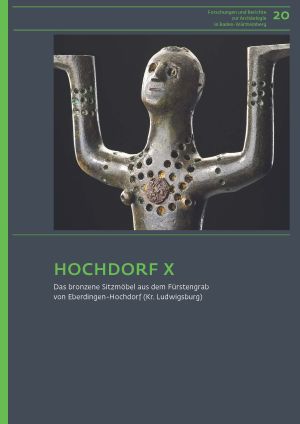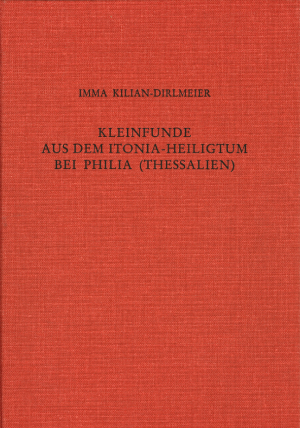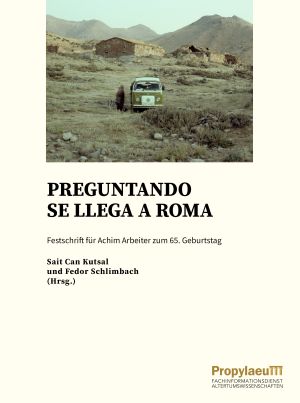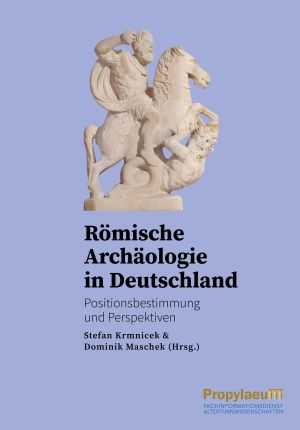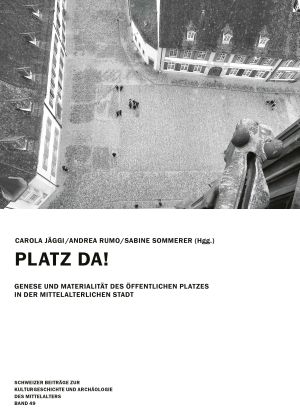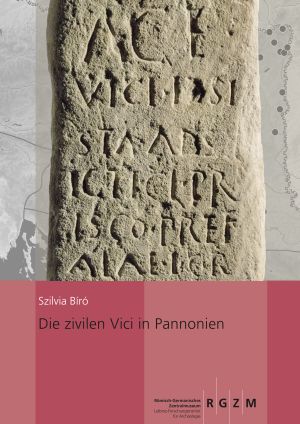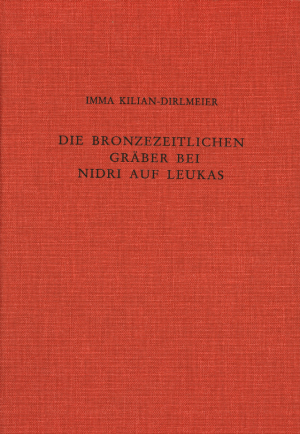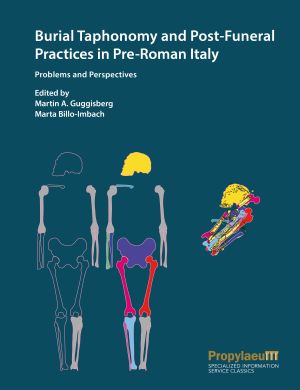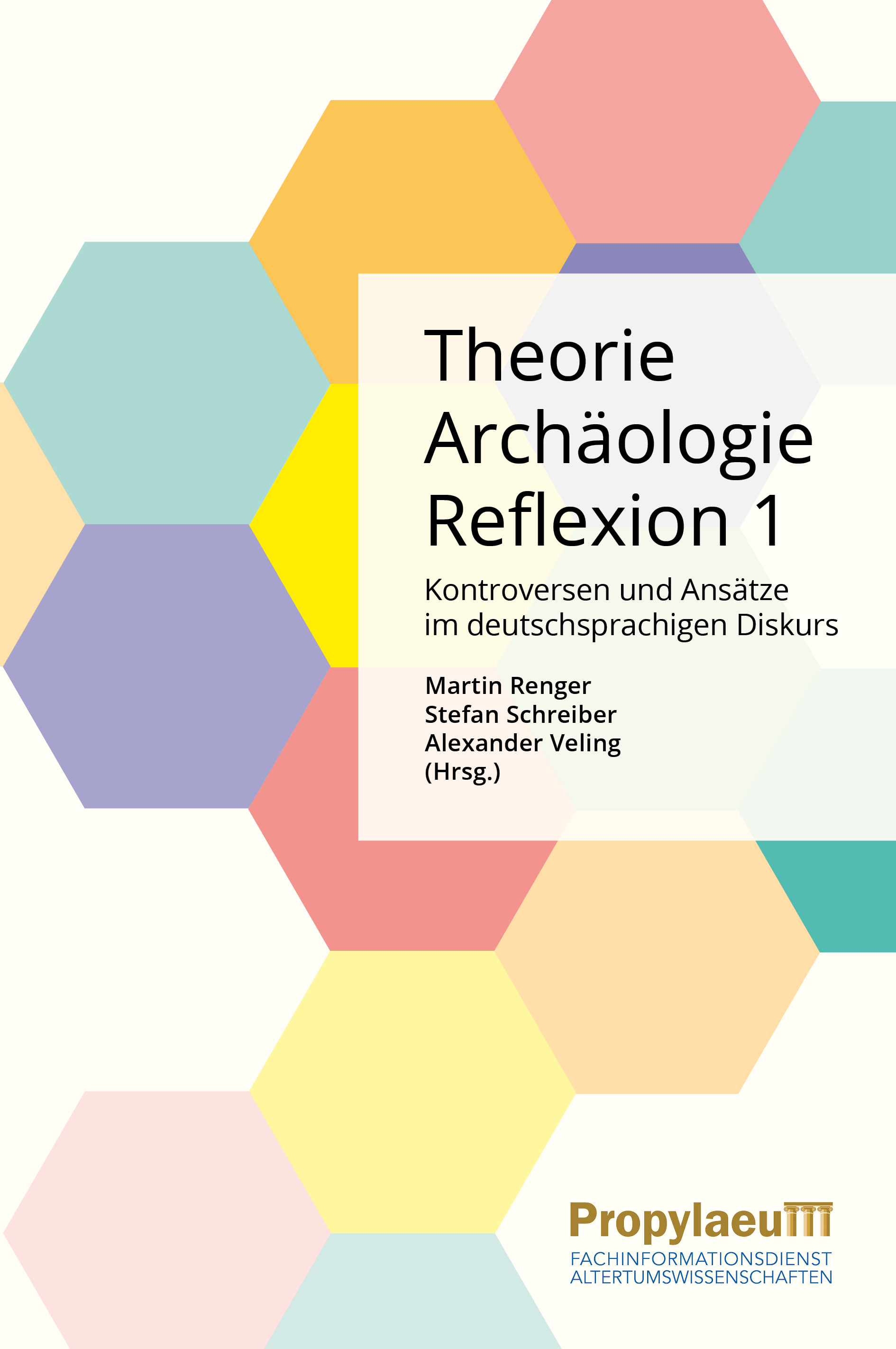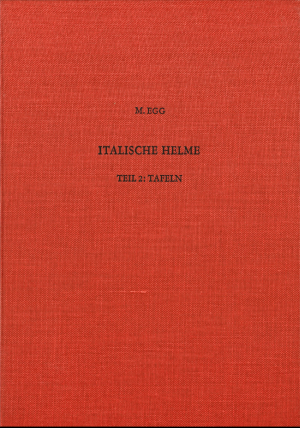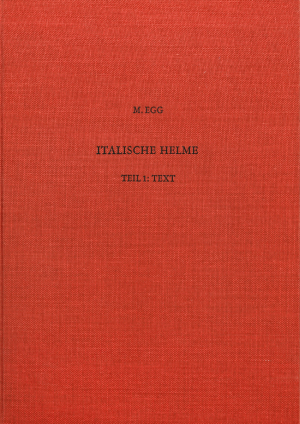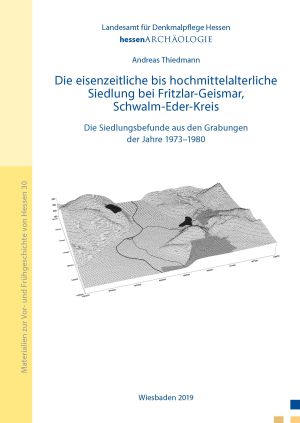Books
Das hallstattzeitliche Fürstengrab von Strettweg bei Judenburg in der Obersteiermark
Strettweg in Upper Styria was the site of one of Austria's most important archaeological discoveries in 1851/52. The richly furnished ceremonial tomb from the Iron Age (around 600 BC) contained, among many other objects, the famous "cult chariot" - a unique masterpiece of Hallstatt-period craftsmanship.
The rich metal grave goods include weapons, horse harness and chariot parts, bronze and clay vessels - in other words, classic prestige goods of Hallstatt-period elites. Grave goods from the female costume suggest offerings to the dead. There is evidence of extensive cultural contacts with the Hallstatt cultures north of the Alps, with Upper Italy and with the ancient world.
Das Erdwerk der Michelsberger Kultur von Bruchsal „Aue“: Eine lange Geschichte
In the "Aue" area on the north-eastern edge of the small town of Bruchsal in Baden, a double ditch from the Michelsberg culture (around 4300–3600 BC) was discovered in 1986 by aerial survey. In 1987–1993, the ditches, which were preserved over a length of around 550 m, were archaeologically investigated almost in their entirety. A surprising discovery were six burial pits at the edge and under the base of the outer ditch with the skeletons of nine children and seven adults, some in a regular and some in an irregular position.
The carefully documented excavation allowed a detailed reconstruction of the building history of the ditch complex. The analysis of the features revealed that the earthwork never existed in its appearance as it is today, but that it is the result of various anthropogenic and natural transformations over a period of six centuries. However, the discussion about the function of the Michelsberg earthworks cannot be settled in Bruchsal “Aue” either – there are indications of a profane settlement use with a defensive character as well as of cultic or ritual activities.
Die bronze- und früheisenzeitlichen Troiafunde der SammlungHeinrich-Schliemann im Römisch-Germanischen Zentralmuseum
The scope of this volume is the comprehensive publication of so-called doublets, for example twin pieces of ceramics and small finds from the holdings of the Berlin museums, which were given to 35 European museums and research institutes in the course of the final inventory in the years 1895-1900 in order to structure the core collection in Berlin better and make it more manageable. The Mainz Troy Collection consists of partly fragmented pottery, partly restored in the workshops of the research institute, from the settlement phases Troy I to VIIb2, i.e., the strata of the early Bronze to early Iron Age according to Anatolian terminology. The inventory of small finds includes objects made of clay, stone, and shell limestone.
"The Bronze Age and Early Iron Age Troy Finds of the Heinrich Schliemann Collection in the Roman-Germanic Central Museum" is thus a contemporary contribution to the reappraisal of the enormous archaeological legacy of Heinrich Schliemann, which has so far only been critically appreciated in rudimentary form.
Die Konzentrationen IIb und IV des Magdalénien-Fundplatzes Gönnersdorf (Mittelrhein)
The Magdalenian site of Gönnersdorf offers unique possibilities for the spatial analysis of a Late Palaeolithic settlement area due to its richness of finds and exceptionally good preservation. While Concentration IV was already the subject of a study published in 1997, Concentration IIb is a previously unexplored settlement structure.
Concentration IIb represents a partial area of the large Concentration II, whose central settlement structure (Concentration IIa) was already dealt with in detail in 2007 (Monogr. RGZM 69). The focus is now on clarifying the function of the settlement structures in Concentration IIb as well as their temporal and spatial relationship to the neighbouring Concentrations IIa and III.
A renewed spatial analysis of Concentration IV seemed to make sense, since digital analysis methods in particular have been considerably refined since the initial work, and some previously untreated partial aspects could now be investigated. This led to detailed results regarding the relationship between latent and evident findings as well as artefact production in K-IV.
Modelling Archaeological Landscapes: Bridging Past and Present in two Mediterranean Islands
In recent years, the increasing significance of cultural (also archaeological) landscapes has presented archaeology with new major challenges, which can only be met through interdisciplinary cooperation and on the basis of participatory initiatives. The urgent need to develop effective concepts for the stewardship of archaeological sites and their natural environment can be the triggering force for replacing the destructive methods of archaeology with creative strategies and thereby for drastically changing the profile of this discipline in research and teaching. These considerations were the focus of the present volume that presents the results of the project “Modelling Archaeological Landscapes. Bridging Past and Present in Two Mediterranean Islands”, which was carried out by the Universities of Heidelberg and Catania in 2018 and funded by the DAAD (German Academic Exchange Service).
Einheit in der Vielfalt? Zur Kulturpflanzennutzung imByzantinischenReich unter besondererBerücksichtigung archäobotanischerUntersuchungen in Caričin Grad(Justiniana Prima)
Plants are of great importance in everyday human life, serving not only as sources of food, but also as a source of raw materials, building materials, fuel or feed for domestic animals. Different plant spectra can therefore provide insights into people's everyday lives, their cultural preferences or environmental conditions. The study deals with crop use in the Byzantine Empire based on archaeobotanical data and has two main foci: on the one hand, the archaeobotanical analysis of macroremains from the early Byzantine city of Caričin Grad in southern Serbia, on the basis of which the diet of the urban population as well as agricultural practices are reconstructed. On the other hand, a literature-based supra-regional and diachronic overview of crop use in the Byzantine Empire (395-1453) is given. In the evaluation at the regional level, characteristic features of crop use of each region and the respective epochs are elaborated against the historical background and the prevailing environmental conditions and then transferred into a supra-regional and diachronic overview.
Die Burgruine Scheidegg bei Gelterkinden: Bericht über die Forschungen 1970–74
The Scheiddegg castle ruins lie on a wooded ridge, away from the busy flow of traffic high above the municipality of Tecknau in the upper reaches of the Ergolz Valley. Under the leadership of the Archaeology Department of Canton Basel-Landschaft, the ruin was examined in 1970–74. Based on the identifiable small finds, the construction of the castle can be dated to between 1220 and 1230. It was destroyed by a (naturally occurring) conflagration around 1320, as attested to by both a massive layer of burnt rubble and an assemblage of finds from every area of the castle inhabitants’ lives. A remarkable discovery was the skeletal remains of seven horses, which probably succumbed to the flames. From an architectural perspective, the castle’s most striking features were a large residential tower, which was reinforced by a round pillar at each corner, and a castle courtyard with a substantial filter cistern.
Das spätkeltische Wagengrab von Boé (Dép. Lot-et-Garonne): Studien zu Wagen und Wagengräbern der jüngeren Latènezeit
In 1959, a complex was discovered in Aquitaine near the Oppidum Agen, which could be identified as a rich grave; a re-excavation by R. Boudet confirmed this in 1990. The grave can probably be assigned to a rex of the Nitiobrogens, who was buried c. 50-35 BC. The pottery includes amphorae (Dressel 1B, Lamboglia 2), Italic (Campana B among others) and local forms. The metal finds are exceptionally rich. A four-wheeled ceremonial wagon, with a construction similar to that of Dejbjerg, could be reconstructed. Chariots have been important components of rich graves since the Bronze Age. Chariot finds from Latène C/D were collected for Central Europe and methodically analysed; the graves were placed in their context.
Das Castel Grande in Bellinzona: Bericht über die Ausgrabungen und Banuntersuchungen von 1967
The fortifications of Bellinzona are some of the most outstanding medieval defences in Switzerland. Throughout history, various forces have fought to gain ownership of the site. The marching sound of Roman legionaries was soon replaced by the cacophony of Germanic and Rhaetian hordes, before the various rulers of Italy took turns in fighting off foreign invaders. It was not until around 1500 when Bellinzona came into the ownership of the Old Swiss Confederacy that the situation became less volatile, and the fortifications gradually lost their military use.
This report does not claim to offer a complete history of the Castel Grande site, as the excavations and architectural study were limited to the south wing of the castle due to construction activities. The archaeological investigations yielded evidence of several phases of construction dating from the 4th to 11th centuries, while the examination of the walls identified elements dating from the first half of the 13th century up to the end of the 15th century. The small finds suggest that the hilltop was settled in prehistoric periods and attest to human presence from the Augustan period to the present. The high medieval finds clearly show influences from the northern foothills of the Alps (stove tiles) and from Italy (majolica). From the 13th century onwards, there was a significantly greater Lombard-Italian influence, which reached its highpoint in the 15th century, with regard to both the artefacts and the architectural design of the fortifications.
Plaidter Hummerich: an early Weichselian Middle Palaeolithic site in the Central Rhineland Germany
The Plaidter Hummerich Middle Palaeolithic site was located on the summit of the eponymous East Eifel volcano, which today has been almost entirely quarried away. To the east lies the flat landscape of the Neuwied Basin and the Rhine Valley. Excavations from 1983-1986 of the stratified ice age deposits of the crater fill yielded approximately 3,000 individual finds of animal remains and 2,000 finds of lithic materials. The latter give an insight into the technological skills of Neanderthals, the rocks used indicate long-range mobility. The remains of predominantly large herbivores - wild cattle, horses, red deer – provide evidence for the abundant wildlife as an available food base.
Kinship, Sex, and Biological Relatedness : The contribution of archaeogenetics to the understanding of social and biological relations
Relationships between people have always been the basis of social coexistence. Kinship – whether it is biological or social – has a very special significance. In archaeology, these immaterial connections have rarely been proven beyond doubt. In recent years, however, the field of archaeogenetics has developed methods and techniques that, given good DNA preservation, make it possible to determine the degree of genetic relatedness between two people who lived in the past.
The studies collected in this book, draw their knowledge on kinship from the fields of anthropology, archaeology, genetics, and the historical and social sciences. They demonstrate, on the basis of recent or previously known sites, which conclusions the new scientific insights allow on the one hand, but on the other hand also point out their limitations in the interpretation of (pre-)historic societies.
Hochdorf X: Das bronzene Sitzmöbel aus dem Fürstengrab von Eberdingen-Hochdorf (Kr. Ludwigsburg)
More than four decades after its excavation, the presentation of the sitting bench, used in its last function as a funeral rest, completes the basic publications on the inventory of the Late Hallstatt period (c. 530 BC) chamber tomb of Hochdorf. The centrepiece of the volume is a catalogue of the overall appearance of this unique piece of furniture, which is based on digital imaging techniques. This is complemented by descriptions of the findings, the recovery, the restoration and production techniques, which close with the presentation of a replica of the piece. Detailed textile archaeological analyses of the rich adhesions on the funerary couch complement the picture. A further focus is on archaeometallurgical examinations of the furniture’s components and its iron substructure. Questions related to the origin of the object are discussed in a cultural-historical study on its southern and italic connections and on the interpretation of the pictorial programme. The volume is completed by bioarchaeological analyses of the deceased from the central grave as well as other burials from the mound area.
Kleinfunde aus dem Itonia-Heilgtum bei Philia (Thessalien)
By epigraphical evidence the sanctuary of the Thessalian Koinon is located near the village Philia, nomos Karditsa (Thessaly). In 1960 deep ploughing in this area teared open the soil until the natural ground, a big quantity of objects was looted by the villagers and part of it reached European and American museums. There were only small places with undsisturbed stratigraphy left, when in 1963-67 D. Theocharis excavated the sanctuary. Therefore it’s mainly the the chronotypological classification of the small finds discussed in this study. Their function – votive, ritual equipment, tool etc. - are also analysed. A diachronical reconstruction of the cult activities refers to the archaeolocical material as well as to the literary tradition.
Preguntando se llega a Roma: Festschrift für Achim Arbeiter zum 65. Geburtstag
The volume contains fifteen essays by students and (former) colleagues of Achim Arbeiter, who celebrates his 65th birthday in 2023 and at the same time also his 25th anniversary as Professor of 'Christian Archaeology and Byzantine Art History' at the Georg-August-Universität Göttingen. The contributions deal with iconographic and iconological aspects of pictorial works, with stylistic, typological and iconographic aspects of architecture, with settlement archaeology, music, ancient traditions in Christian saint cults and the multiple occupation of graves. Chronologically, the studies range from Late Antiquity to the Middle Ages; geographically, they lead from the Levant via North Africa, the Balkans and Italy to the Iberian Peninsula.
I tripodi a verghette in Etruria e in Italia centrale: Origini, tipologia e caratteristiche
The Etruscans were excellent bronze craftsmen: this is proven both by numerous archaeological finds and ancient written sources. Especially between the 6th and 5th centuries BC, the Etruscan bronze workshops reached a very high level of craftsmanship and specialised in the production of household goods and banquet accessories, which were exported to all corners of the Mediterranean and north of the Alps.
Among the most valuable creations of the Etruscan bronze craftsmen were the staff trivets, a kind of stand assembled from several cast pieces and decorated with small figurative decorations. As one of the most important and significant elements of banquet accessories, they were often part of lavish funerary furnishings inside and outside Etruria, and because of their symbolic value they were even consecrated in sanctuaries. Their peculiarity emerges above all from the figural representations that adorned them and at the same time marked them as bearers of mythological stories.
A detailed study clarifies the typological connections of these Etruscan works of art with their models from the Near East and Greece by carefully examining all their technological and stylistic aspects. Thus, the significance of the staff triforms and their nature of prestigious objects for the Etruscan and non-Etruscan elites is fully revealed.
Platz Da! Der öffentliche Platz in der mittelalterlichen Stadt
Many recent publications have dealt with medieval town squares as public spaces and stages to assert political power, and as “theatres” of ritual and social interaction. This volume comprises 16 presentations held at a conference in Zurich in 2017.
Researchers have, at times, lost sight of the genesis and materiality of public squares in the towns and cities concerned. Rarely have they asked when, where and by whom were the squares created; what components were used to demarcate them; how were they accessed; how were the surfaces reinforced; and how did their physical appearance change over the centuries?
The theme of the conference was the public square as a physical component of the fabric of a medieval town or city. Individual towns and cities were looked at as separate units of study whose undeveloped areas were then compared in terms of their genesis and how they functioned within the urbanistic context. It goes without saying that both archaeological contexts and historical sources were consulted.
La decorazione pittorica e in stucco della Necropoli Laurentina di Ostia
The book focuses on the stuccos and painted decoration of the Laurentina Necropolis in Ostia. The necropolis was almost exclusively used by slaves, liberti (freedman) and their families, and is of particular interest for its long occupation (1st century BC-3rd century AD). The iconographic and iconological analyses of the decorations are supported by a catalogue of the different burials, where they are thorough described also including archival documentation of lost pieces of evidence. Furthermore, the results of multispectral imagery and 3D reconstruction conducted on selected burials enrich and integrate the description and study of the necropolis. Ultimately, the book shed new light not only on the history and evolution of the Necropolis Laurentina, but also allows to investigate existing relations of economic, social and cultural dependencies between freedmen and aristocrats.
Die zivilen Vici in Pannonien
The civil vici show different characteristics in building forms and settlement structures in the western provinces than those in the eastern provinces. Pannonia had to be of special importance as a link. Here one finds rather village settlements with strong pre-Roman roots next to the "traditional" small-town settlements.
Based on the results of the numerous recent excavations, this study sheds light on the role of the Zivilvici in the economic life of the province, the characteristics of building and settlement structure or their social composition. With regard to the Romanisation process, the survival of various pre-Roman elements in the vici and the changes in pre-Roman settlement structures were also investigated.
Die bronzezeitlichen Gräber bei Nidri auf Leukas: Ausgrabungen von W. Dörpfeld 1903-1913
This volume is a revised study of the Early and Middle Helladic tombs excavated by W. Dörpfeld in 1903-1913 on the island of Leukas/Levkada. In addition to his publication “Alt-Ithaka” (1927) his diaries, note books and photographs could be used. There are new results concerning tomb architecture, tomb offerings, the organization of the cemeteries and sozial structures. Imports from the Cycladies, the Greek mainland, the Black Sea region and the Adriatic coasts indicate long distance connections. How to explain hierarchy and wealth on a small island at the periphery of the EH II Aegean?
Burial Taphonomy and Post-Funeral Practices in Pre-Roman Italy: Problems and Perspectives. Papers of the International Workshop held at the University of Basel, January 12th, 2021
The volume includes papers with individual contributions by the authors dealing with taphonomic processes as well as post-funeral practices and reuse of graves, which could be determined. It is shown that besides the state of preservation, the methods of investigation are enormously important in order to be able to recognize, for example, multiple burials. Likewise, the phenomenon of a closed context, as is quickly assumed in the discovery of a grave, is not a matter of fact in the case of the examples presented. The scientific analyses and evaluations help to understand both the biological and the cultural processes that occur or are carried out after the death of an individual.
Theorie | Archäologie | Reflexion 1: Kontroversen und Ansätze im deutschsprachigen Diskurs
The double volume “Theory | Archaeology | Reflection. Controversies and approaches in German-language discourse” is dedicated to the diversity of approaches that shape archaeological theoretical discourse today and in the near future. To this end, it brings together groundbreaking contributions, exciting thought experiments and initial theoretical approaches across the archaeological spectrum. Both established and young academics contribute new impulses and approaches to the discourse or discuss existing approaches. The articles of the first volume focus on disciplinary definitions, standpoints and positioning, as well as on questions of ethics and responsibility in archaeologies.
Italische Helme
Using the example of the Italian helmets, the area of influence of the Etruscans in Picenum, in Upper Italy and in the Alpine region as well as the interactions between the different cultural groups can be traced.
The Etruscans developed the helmet type with a circumferential brim in the 7th century BC; in the course of the 6th century a throat was added to secure the crest. The Negau helmet was typical of the Archaic period. It disappeared in Central Italy in the 4th century, but remained in use in the Alpine region until the 1st century BC. In the Tyrolean region and in eastern Switzerland, the helmets were not found as prestige goods in graves, as was usually the case, but in sacrificial sites, often badly damaged by fire. Similar to Greece, such helmets captured in war were a high-value consecration gift.he Italian helmets, the area of influence of the Etruscans in Picenum, in Upper Italy and in the Alpine region as well as the interactions between the different cultural groups can be traced.
Vol. 1, see.
Italische Helme
Using the example of the Italian helmets, the area of influence of the Etruscans in Picenum, in Upper Italy and in the Alpine region as well as the interactions between the different cultural groups can be traced.
The Etruscans developed the helmet type with a circumferential brim in the 7th century BC; in the course of the 6th century a throat was added to secure the crest. The Negau helmet was typical of the Archaic period. It disappeared in Central Italy in the 4th century, but remained in use in the Alpine region until the 1st century BC. In the Tyrolean region and in eastern Switzerland, the helmets were not found as prestige goods in graves, as was usually the case, but in sacrificial sites, often badly damaged by fire. Similar to Greece, such helmets captured in war were a high-value consecration gift.
Vol. 2, see.
Die eisenzeitliche bis hochmittelalterliche Siedlung bei Fritzlar-Geismar, Schwalm-Eder-Kreis: Die Siedlungsbefunde aus den Grabungen der Jahre 1973–1980
From 1973–1980 excavations were conducted by the the Hessian State Office for the Preservation of Monuments at the site of "Alt-Geismar" near Fritzlar in northern Hesse. The settlement covered arguably up to 7 hectares and was continuously inhabited for more than one and a half millennia. Andreas Thiedmann’s scientific study presents and evaluates the settlement features of this important site for Hesse’s settlement archaeology. The comprehensive treatise illuminates the various aspects of living in a rural settlement and provides detailed insight into its development and supra-regional interactions from the Iron Age to the high Middle Ages.
Studien zur spätbronzezeitlichen Chronologie im westlichen Mitteleuropa und in Westeuropa
The studies were carried out as preliminary work for an investigation of the Bronze Age river finds from the northern Upper Rhine. Based on the Late Bronze Age chronology advocated by the author since 1987, on the Hallstatt B chronology of Swiss research (limited to Switzerland and its immediate surroundings) and on dendrochronological data also for Bronze Age D, the possibilities of the stage division, the time approaches of the stage boundaries and the supra-regional validity of these stages and stage boundaries were again explored. It is not a matter of a systematic description of the contents of the stages, but rather of proving in principle that the close-meshed sequence of stages in stages of mostly 60 years, which can be found on the Rhine, Moselle and in Switzerland, can be transferred to the Urnfield Culture over a wide area, and can also serve as a standard for the chronology of the Atlantic Bronze Age.



